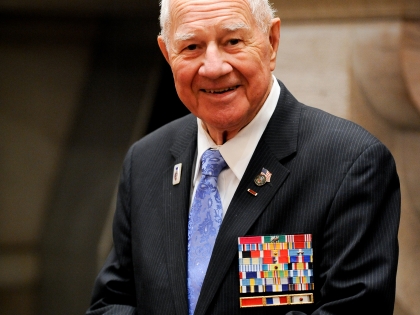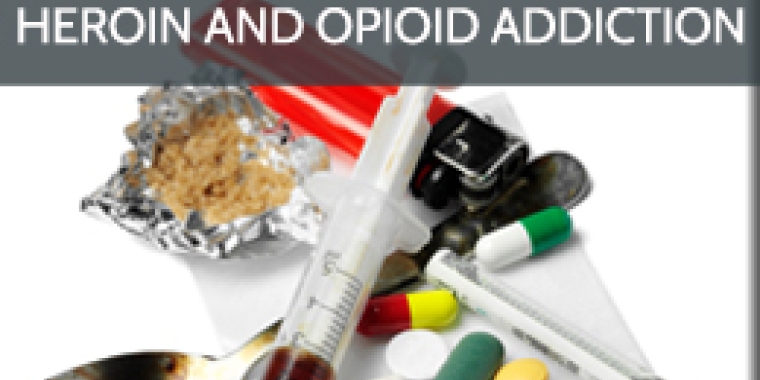
Senate Passes Bills Recommended by Heroin Task Force
William J. Larkin Jr.
June 9, 2014
-
ISSUE:
- Drugs

Measures Will Help Address Growing Heroin and Opioid Use in New York
The New York State Senate today passed 23 bills to address issues surrounding the increase in heroin and opioid abuse, addiction, and related crimes in New York. The bills are part of a comprehensive legislative package proposed by the bipartisan New York State Senate Joint Task Force on Heroin and Opioid Addiction in a report released in May.
The bill package passed today begins the legislative response laid out in the report to prevent drug abuse and overdoses; increase the availability and efficacy of addiction treatment; and enhance the tools provided to law enforcement to keep heroin off the streets.
In March 2014, New York State Senate Majority Coalition Co-Leaders Dean Skelos and Jeffrey Klein created the Joint Task Force on Heroin and Opioid Addiction to examine the alarming rise in use of heroin and opioids that has claimed lives and hurt families across New York State. The task force is chaired by Senator Phil Boyle (R-C-I, Suffolk County), Chairman of the Senate Committee on Alcoholism and Drug Abuse, along with Vice-Chair David Carlucci (D-Rockland), Chairman of the Senate Committee on Mental Health and Developmental Disabilities; and Vice-Chair Michael Nozzolio (R-C, Fayette), Chairman of the Senate Codes Committee.
The task force report released last month proposed a package of bills to target the prevention, treatment, and enforcement issues raised during extensive testimony provided by dozens of experts, parents, and concerned New Yorkers during 18 forums held throughout the state.
Senator Boyle said, “As a Heroin Task Force, we hosted 18 forums across the state, heard from 276 panelists, had over 2,300 attendees, and listened to over 60 hours of testimony. The information and insights we have gained as a result of these forums, and the added input from countless New Yorkers affected by this epidemic, has helped us craft these 23 pieces of legislation. These bills supported by Republicans and Democrats will encourage prevention, enhance treatment options and strengthen law enforcement as we combat this unprecedented epidemic. By working together, across party lines, we will save lives and prevent tragedies.”
Senator Carlucci said, “By passing these critical pieces of legislation we made sure to address the fact that there exists a frightening heroin epidemic that is plaguing our communities and putting our children at risk. This multipronged approach will save lives by focusing on recovery and prevention while closing a loophole in our current system that lets victims fall through the cracks.”
Senator Nozzolio said, “The heroin epidemic is destroying countless lives and families across our state and nation. The legislation proposed by the Senate Task Force focuses on providing additional resources for the prevention of drug abuse and the treatment of those addicted, while giving law enforcement officials the tools they need to prosecute criminals who are spreading heroin in our local communities. The adoption of this legislation represents an important first step towards fighting the heroin epidemic, which has become all too prevalent in our suburbs, small cities and rural areas.”
One of the bills (S7661), sponsored by Senator Kemp Hannon (R, Nassau), would increase access to the heroin overdose antidote naloxone by allowing it to be possessed and administered in schools and other educational institutions. Long Island addiction experts testified to the task force that they are counseling heroin users as young as 12 years old. Having naloxone in schools could help save the life of a child in the event of an overdose.
The Binghamton Press and Sun Bulletin last week reported that firefighters have used naloxone to save seven lives in the last two months alone. Recently, the NYPD reported it would soon be equipping officers in precincts citywide with naloxone to combat the spike in heroin overdoses.
The task force bills passed today include:
Preventing Opioid Abuse and Overdoses
· Preventing opioid overdoses in schools (S7661, Hannon): Clarifies that school districts, Board of Cooperative Educational Services (BOCES) programs, charter schools, and other educational entities may possess and administer naloxone to treat opioid overdoses, and will be protected by Good Samaritan laws.
· Increasing the effectiveness of overdose prevention (S7649A, Marchione): Provides that naloxone kits distributed through an opioid overdose prevention program must include an informational card with instructions on steps to take following administration, as well as information on how to access addiction treatment and support services. Opioid overdose prevention programs provide those at risk of an overdose, their family members and their friends with naloxone kits and training on proper administration.
· Limiting prescriptions for acute pain (S2949A, Hannon): Limits the number of Schedule II and III controlled substances prescribed for acute pain to a 10-day supply to prevent excess pharmaceuticals from being dispensed, and therefore reduce the risk of diversion. This restriction would not apply to the treatment of cancer pain, chronic pain or palliative care. Further, the bill provides that only one co-payment may be charged for a 30-day supply.
· Increasing public awareness (S7654, Boyle): Requires the Office of Alcoholism and Substance Abuse Services (OASAS) and the Department of Health (DOH) to establish the Heroin and Prescription Opioid Pain Medication Addiction Awareness and Education Program. The program would utilize social and mass media to reduce the stigma associated with drug addiction, while increasing public’s knowledge about the dangers of opioid and heroin abuse, the signs of addiction, and relevant programs and resources.
· Establishing school drug prevention programs (S7653, Martins): Adds age-appropriate information about the dangers of illegal drug use to junior high school and high school health class curriculums.
· Promoting pharmaceutical take-back events (S6691, Boyle): Requires OASAS to post guidelines and requirements for conducting a pharmaceutical collection event on its website. According to the Substance Abuse and Mental Health Service Administration (SAMHSA), nearly 70 percent of those who first abuse prescription drugs get the pills from a friend or relative. Facilitating proper and timely disposal of unused narcotics helps to reduce the danger of diversion.
· Ensuring prescribing practitioners stay abreast of best practices (S7660, Hannon and Maziarz): Creates a continuing medical education program for practitioners with prescribing privileges. DOH and the State Education Department (SED) would establish standards for three hours of biennial instruction on topics including Internet System for Tracking Over-Prescribing (I-STOP) requirements, pain management, appropriate prescribing, acute pain management, palliative medicine, addiction screening and treatment, and end-of-life care.
Increasing the Availability and Efficacy of Addiction Treatment
· Creating a new model of detoxification and transitional services (S2948, Hannon): Establishes the Opioid Treatment and Hospital Diversion Demonstration Program, requiring the development of a new model of detoxification and transitional services for individuals seeking to recover from opioid addiction that reduces reliance on emergency room services.
· Establishing a relapse prevention demonstration program (S7650, Carlucci): Creates a Wraparound Services Demonstration Program through which OASAS would provide case management or referral services for nine months to individuals who successfully complete substance abuse treatment programs. These community supports - access to which is intended to prevent a relapse - include educational resources, peer-to-peer support groups, social services and family services and counseling, employment support and counseling transportation assistance, medical services, legal services, financial services, and child care services.
· Enabling parents to require children to undergo treatment (S7652A, Martins): Provides that a parent or guardian may petition to have a minor child designated as a Person in Need of Supervision (PINS) due to a substance use disorder, and that a court may require a PINS child to undergo substance abuse treatment.
· Establishing assisted outpatient treatment for substance use disorders (S7651A, Carlucci): Enables a court to order Assisted Outpatient Treatment (AOT) for an individual with a substance use disorder who, due to his or her addiction, poses a threat to him or herself or others.
· Promoting the affordability of substance abuse services (S7662A, Seward, Hannon, Martins and Ritchie): Improves the utilization review process for determining insurance coverage for substance abuse treatment disorders, and requires insurers to continue to provide coverage throughout the appeals process.
Providing Additional Resources to Law Enforcement
· Studying the conversion of correctional facilities to treatment centers (S7655A, Boyle and Nozzolio): Directs OASAS and the Department of Corrections and Community Supervision (DOCCS) to study the feasibility of converting closed correctional facilities to provide treatment for substance use disorders. Agencies would examine the feasibility of such centers providing both inpatient residential and outpatient care.
· Establishing the crime of homicide by sale of an opioid controlled substance (S7657, Robach): Creates an A-I felony for the unlawful transportation or sale of an opioid that causes the death of another.
· Restricting drug dealers from participating in the SHOCK incarceration program (S7656, Nozzolio): Holds drug dealers accountable by preventing participation in the SHOCK incarceration program – under which young adults receive substance abuse treatment, academic education, and other services to promote reintegration – by individuals convicted of a A-II felony drug offense, except if he or she tests positive for a controlled substance upon arraignment.
· Creating Drug-Free Zones around treatment facilities (S1388, Skelos): Establishes a B felony for the sale of a controlled substance within 1,000 feet of a drug or alcohol treatment center or methadone clinic.
· Improving safety at judicial diversion programs (S1879A, Bonacic): Requires a court, in determining a defendant's eligibility for a judicial diversion program for alcohol or substance abuse treatment, to consider the underlying charges and the defendant's propensity for violent conduct. The bill also requires the facility treating a defendant under this diversion program to notify the local law enforcement of the defendant's placement and arrest record, and to submit a security plan to the Division of Criminal Justice Services (DCJS) to provide for the safety of staff, residents and the community. Finally, this bill allows a defendant to appear via video conference, and makes unauthorized departure from a rehabilitation facility a D felony.
· Reallocating funds from asset forfeitures (S7658, Nozzolio): Reduces the state share of certain asset forfeitures to increase allocations for the reimbursement of expenses incurred by localities for investigation and prosecution, and provides additional monies for the Chemical Dependence Service Fund.
· Expanding the crime of operating as a major trafficker (S7663, Nozzolio): Facilitates convictions for operating as a major trafficker by reducing the number of people that must have participated from four to three, and lowering the minimum required proceeds from the sale of controlled substances during a 12-month period from $75,000 to $25,000.
· Establishing the crime of transporting an opioid controlled substance (S7659, Boyle): Allows prosecution for a new crime when an individual unlawfully transports an opioid any distance greater than five miles within the state, or from one county to another county within the state, to address diversion and distribution of heroin and prescription drugs.
· Facilitating the conviction of drug dealers (S7169, Boyle): Provides that possession of 50 or more packages of a Schedule I opium derivative, or possession of $300 or more worth of such drugs, is presumptive evidence of a person’s intent to sell.
· Establishing criminal penalties for the theft of blank official New York State prescription forms (S2940, Hannon): Expands grand larceny in the fourth degree to include the theft of a blank official New York State prescription form. This bill would also redefine criminal possession of stolen property in the fourth degree to include the possession of a stolen New York State prescription form, and create an A misdemeanor of criminal possession of a prescription form.
· Prosecuting acts by street gangs (S4444A, Golden): Creates the Criminal Street Gang Enforcement and Prevention Act to provide a comprehensive approach to protecting the public from gang-related crimes and violence, including those that relate to drug trafficking, and establishing the criminal street gang prevention fund.
Members of the bipartisan task force include Senator Greg Ball (R-C-I, Patterson), Senator John Bonacic (R-C-I, Mount Hope), Senator Simcha Felder (D-Brooklyn), Senator Pat Gallivan (R-C-I, Elma), Senator Martin J. Golden (R-C-I, Brooklyn), Senator Joseph A. Griffo (R, Rome), Senator Kemp Hannon (R, Nassau), Senator Andrew Lanza (R-I-C, Staten Island), Senator William Larkin (R-C, Cornwall), Senator Betty Little (R-C-I, Queensbury), Senator Carl L. Marcellino (R, Syosset), Senator Kathleen A. Marchione (R-C, Halfmoon), Senator Jack Martins (R-C-I, Mineola), Senator George Maziarz (R-C, Newfane), Senator Thomas O’Mara (R-C, Big Flats), Senator Michael Ranzenhofer (R-C-I, Amherst), Senator Patty Ritchie (R-C, Heuvelton), Senator Joseph Robach (R-C-I, Rochester), Senator Diane Savino (D, Staten Island/Brooklyn), Senator James L. Seward (R-I-C, Oneonta), Senator David J. Valesky (D-Oneida), and Senator Cathy Young (R-I-C, Olean).
The Senate today also passed the following bills related to curtailing drug use in New York:
- S2447, sponsored by Senator Jeff Klein (D, Bronx): gives state drug and law enforcement agencies and individuals the another tool to combat the quickly moving world of designer drugs by closing a loophole that allows manufacturers to avoid prosecution by making minor chemical alterations to drugs.
- S2173A, sponsored by Senator Golden: protects the safety of children and their families by providing enhanced penalties for the sale of controlled substances in playgrounds and park grounds.
- S3289, sponsored by Senator O’Mara: makes the penalties for the possession and or sale of methamphetamine similar to that of the penalties for possession and/or sale of heroin and cocaine.
- S3407B, sponsored by Senator Klein: penalizes those who knowingly maintain a building in a fortified condition that is used to manufacture, package or distribute controlled substances or marihuana.
- S4652B, sponsored by Senator Valesky: implements an electronic tracking system on the sale of products containing pseudoephedrine, or ephedrine. This system will communicate in real time, across state lines and produce a stop sale notification to the seller of the product.
- S3985A, sponsored by Senator Mark Grisanti (R-I, North Buffalo): establishes a demonstration drug disposal program in representative rural, suburban and urban areas of the state in order to provide data that could be used to determine the most effective methods of disposal.
- S7125, sponsored by Senator Hannon: helps prevent the abuse and diversion of opioid analgesic drugs by ensuring that opioid analgesic drugs that incorporate abuse-deterrent technologies are dispensed whenever possible.
The bills have been sent to the Assembly, with the exception of S3985A, which has received final passage, and will be sent to the Governor for consideration.
Share this Article or Press Release
Newsroom
Go to NewsroomSenator Larkin Announces Correction Officer Exam
December 8, 2016
THANKSGIVING ESSAYS AND CONTRIBUTIONS SD 39
November 22, 2016

Larkin and Skoufis Announce Renaming of Road for Community Leader
October 26, 2016